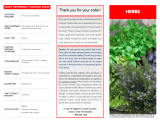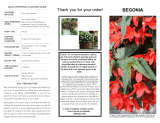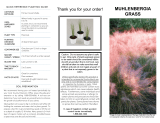Page is loading ...

**IImmaaggee oonn ccoovveerr iiss rreepprreesseennttaattiivvee ooff tthhee ttyyppee ooff ppllaanntt((ss)) iinn tthhiiss ooffffeerr aanndd
nnoott nneecceessssaarriillyy iinnddiiccaatti
ivvee ooff aaccttuuaall ssiizzee oorr ccoolloorr ffoorr tthhee iinncclluuddeedd vvaarriieettyy
.
Thank yyou ffor yyour oorder!
There's nothing quite as tasty as fresh fruit
harvested from your own garden. Not only are
lemon trees treasured for their delicious fruits,
they make a valuable ornamental asset on the
patio, balcony, or even indoors. With these
exceptional plants, you'll enjoy gorgeous
foliage, intensely fragrant blooms, and fresh
fruits perfect for making lemonade, pies, savory
dishes, and more!
Caution:
Do nnot aassume aany pplant iis ssafe tto eeat.
Only pparts oof pplants eexpressly ggrown tto bbe eeaten
should bbe ccons
idered eedible. AAs wwith aany pproduct
that iis nnot ffood, ccare sshould bbe ttaken tto mmake
sure tthat ssmall cchild
ren aand ppets ddo nnot iingest
any ppart oof aa pplant tthat iis nnot eexpressly ggrown tto
be eeaten.
Unless specifically stated, this product is
intended for ornamental horticultural use only
and is not intended for consumption or ingestion
by humans or pets. Most plants are harmless
but some contain toxic substances which can
cause adverse health effects. Furthermore, some
individuals and some animals are sensitive or
allergic to certain plants and precautions should
be taken to limit or avoid physical contact with
particular plants. Some plants have thorns or
spines that can be painful if handled.
In ccase oof iingestion ccontact aa ppoison
control ccenter iimmediately.
1-8800-2222-11222
CCIITTRRUUSS
SOIL PREPARATION
Full sun.
LIGHT/SUN
EXPOSURE
USDA
HARDINESS
ZONES
PLANTING
DISTANCE
IN-GGROUND
At least 10 feet apart.
Winter hardy in ground in zones
8 to 11.
In zones 3 to 7, we recommend
planting in a container so you can
move the plant indoors before the
first frost.
MATURE
HEIGHT // SSPREAD
8 to 10 feet tall with a similar
spread.
Planting in a container will limit
the plant’s growth and keep it at
a more manageable size.
Spring.
3 years.
Edible fruit.
Fragrant blossoms.
Great for containers.
BLOOM TTIME
TIME TTO RREACH
MATURITY
FACTS OOF NNOTE
PLANT TTYPE
Annual/Tropical.
CONTAINER SSIZE
One plant per 24-inch or larger
container.
We recommend having your soil tested periodically by
your local County Extension Office (www.nifa.usda.gov/
extension or by calling 1-800-333-4636). A soil test can
determine if your soil needs any amendments to enhance
the growth and performance of your plants.
Ideal garden soil is easy to dig in and drains well while still
holding the nutrients and water vital to plant growth. To
prepare a bed for in-ground planting, spade or till the soil
to a depth of roughly 12-18 inches. Next, spread a 2-4 inch
layer of organic matter such as compost, shredded leaves
or peat moss over the soil and mix well.
QUICK REFERENCE PLANTING GUIDE

PLANTING INSTRUCTIONS (Continued)
PLANTING INSTRUCTIONS
SHIPPED AAS SSHOWN
Adequate and consistent watering is essential during
your plant's first year in the garden. Infrequent, long
soakings of water that thoroughly saturate the soil
are more effective than frequent, light applications of
water.
Due to variable geographical and environmental
conditions, a specific watering schedule is difficult to
define. However, as a rule of thumb, you should not
allow the soil or the original root ball to completely
dry out. During the first summer, you may need to
water as often as every few days in periods of
drought and extreme summer heat. To determine if
your plant needs water, dig a few inches into the soil
next to the plant. If the soil is dry 2-3 inches below the
surface, it is time to water.
Overwatering can be as damaging as under watering.
Be sure that the area surrounding your plant has
adequate drainage to move water away from the
plant. If you choose to plant in a container, always
select one with drainage holes to prevent your
plant's roots from sitting in water.
FFEEEEDDIINNGG
Feed your plant once every 2-3 weeks during the
growing season with a water-soluble fertilizer for fruits
and vegetables. Discontinue fertilizing by September
1st to allow the plant to prepare for winter. Resume
fertilizing when new growth appears in spring.
MMUULLCCHHIINNGG
Apply a 2-4 inch layer of shredded bark, compost,
leaves, straw or other organic matter around your
plants to promote moisture retention, maintain
even soil temperatures and discourage weed
growth. Replenish the mulch as needed.
Lemons are ready for harvest when they have turned
from solid green to yellow. Ripe lemons should feel
firm and have a slightly glossy appearance. Remove
the ripe fruits from the tree with a gentle twisting
motion or by using hand pruners to snip the stems.
After picking, lemons can be stored in a cool place
for up to two weeks. Do not consume any other part
of the plant.
WWIINNTTEERRIIZZIINNGG
In mild zones (8-11), citrus plants may be left in the
ground during winter. If freezing weather is expected,
protect the roots by mounding a 6-8 inch layer of
shredded bark, compost, leaves, straw or other
organic material around the base of the plant. Potted
plants should be moved into a protected area on
exceptionally cold nights.
In colder zones (3-7), citrus plants should be grown in
containers and moved indoors before the first frost.
Select a room that is bright, preferably one with
southern exposure. Indoors, plants tend to dry out
from a lack of humidity. To boost the humidity level
around your plant, fill a shallow tray with gravel and
water then place the pot in the tray. The water level
should be slightly below the gravel so that the pot is
not submerged in water. As the water evaporates, it
will create a more humid environment for your plant.
Watering should be reduced significantly while the
plant is indoors. Do not overwater or allow your
plant to sit in water. Remove any unsightly or dead
growth over the winter to keep your plant looking
attractive.
In spring when temperatures begin to rise, ease the
plant into a full watering schedule and move it back
outdoors for the summer.
CONTINUING CARE (Continued)
A
We strongly recommend planting in a container in order
to properly protect the plant from winter damage. Use the
following instructions as a guide for container planting.
Important:
Thoroughly hydrate the plant by submersing
the root zone in a container of water for 10 minutes while
you prepare for planting.
B
Water well and, if necessary, adjust the plant so it is
upright and add additional soil if needed, Check to
be sure the plant is not planted too deeply. If it is,
raise the plant carefully and re-firm the soil.
C
Once the plant is properly positioned in the pot,
begin filling the pot with soil. Work the soil around
the root ball with your hands, firming the soil
around the plant with your fingers. When the hole is
filled, tamp the soil to remove any air pockets.
D
Fill the container with soil to within 4 inches of the
top. Remove the pot and prepare the root ball for
planting by gently disturbing the surface roots with
your fingers, fork, or gardening tool and pruning
any damaged roots. Dig a hole in the soil to insert
the lower part of the root ball.
Remove any dead, damaged or unsightly growth as
needed to maintain an attractive appearance. Clip
off any growth emerging from the roots to ensure
your plant keeps its form. Any branches that
become overlapped should be removed in early
spring to encourage better air circulation and to
allow light to reach the center of the plant.
PPRRUUNNIINNGG
WWAATTEERRIINNGG
HHAARRVVEESSTTIINNGG
Stake the plant to allow strong roots to develop and to
help keep it upright, particularly in windy conditions.
CONTINUING CCARE
Your plant has been shipped to you in a pot. We urge you
to remove it from the shipping box and plant it as soon as
possible. Should planting be delayed due to weather or
other unforeseen circumstances, roll the plastic bag down
around the plant and place it near a bright window or
other sunny location. Keep it well-watered in its pot until
permanently planted. Once planted, it will begin setting
roots and, as the weather warms, begin showing new
growth. Please plant as soon as possible, provide reasonable
care and be patient.
CITRUS
The foliage on potted plants may appear slightly wilted or
yellow upon arrival. This is due to the stress of shipping
and is usually nothing to worry about. Water the plant
thoroughly, place it in a shady location and remove any
foliage that does not recover.
OUT OF THE BOX
/






